Biology Dept Kenyon College |
|

|
Biology Dept Kenyon College |
|

|
|
Animal development: Gastrulation Animal development: Neurulation and organogenesis "It
is not birth, marriage, or death, but gastrulation,
which is truly the most important time in your life."
During gastrulation, cell movements result in a massive reorganization of the embryo from a simple spherical ball of cells, the blastula, into a multi-layered organism. During gastrulation, many of the cells at or near the surface of the embryo move to a new, more interior location. The primary germ layers (endoderm, mesoderm, and ectoderm) are formed and organized in their proper locations during gastrulation. Endoderm, the most internal germ layer, forms the lining of the gut and other internal organs. Ectoderm, the most exterior germ layer, forms skin, brain, the nervous system, and other external tissues. Mesoderm, the the middle germ layer, forms muscle, the skeletal system, and the circulatory system. This fate map
diagram of
a Xenopus blastula shows cells whose fate is to become ectoderm in blue
and green, cells whose fate is to
become
mesoderm in red, and cells whose
fate
is to become endoderm in yellow.
Notice
that the cells that will become endoderm are NOT internal!
from LIFE: The Science of Biology, Purves et al, 1998 Although the details of gastrulation differ between various groups of animals, the cellular mechanisms involved in gastrulation are common to all animals. Gastrulation involves changes in cell motility, cell shape, and cell adhesion. Below are schematic diagrams of the major types of cell movements that occur during gastrulation.
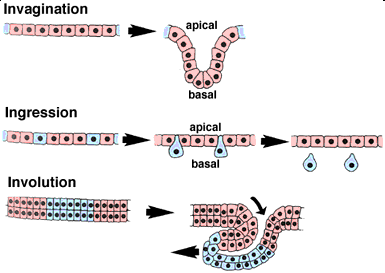
from the Amphibian Embryology Tutorial
Sea urchin gastrulation
Primary mesenchyme cells undergo ingression at the onset of gastrulation, in part due to changes in their cell-adhesion properties. 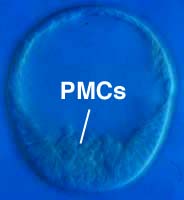 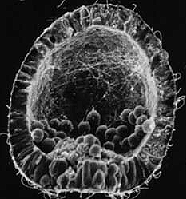 from the Sea Urchin Embryology Tutorial
The vegetal plate undergoes primary invagination to produce the archenteron (primitive gut). Primary invagination is thought to result from changes in the shape of cells in the vegetal plate.
Secondary invagination involves the elongation of the archenteron across the blastocoel, where it attaches near the animal pole of the embryo.
Secondary invagination is thought to involve filapodia extended by the secondary mesenchyme cells located at the tip of the archenteron. This high magnification view shows a filopodium extended by a secondary mesenchyme cell.
Secondary invagination also involves convergent extension. These images show the rearrangement of a labelled clone of cells during archenteron elongation. In the image on the left, the clone of labelled cells has smooth boundaries; by the end of gastrulation, shown on the right, the labelled cells have intercalated with neighboring unlabeled cells to generate a jagged boundary.
Xenopus gastrulation  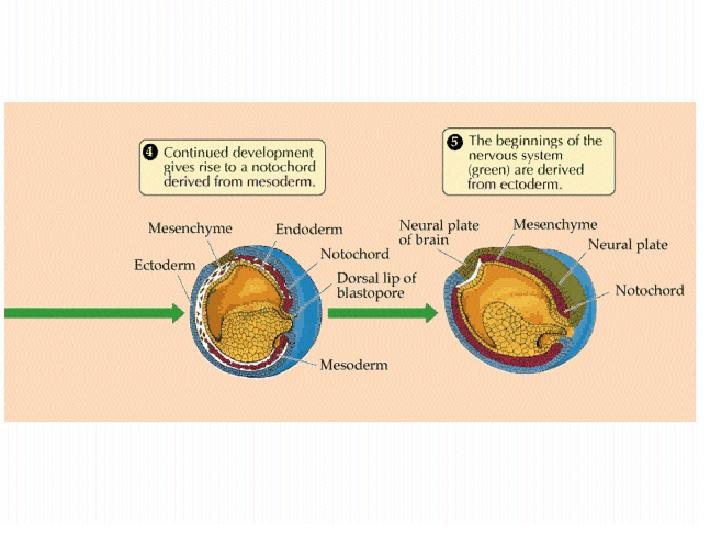 from LIFE: The Science of Biology, Purves et al, 1998 This movie was constructed from a series of cross-sectional images taken by confocal microscopy during Xenopus gastrulation. The animal pole is up, and dorsal is to the right. Use the control panel to move through the image in order to see all of cell migrations occuring during this complex and dynamic process! This video show the surface of a Xenopus embryo surface during gastrulation. Early on, the dorsal lip of the blastopore forms due to the contraction of bottle cells (see below). The blastopore continues to develop from the early "frown" until it can be observed as a complete circular ring of involuting cells. Convergent extension closes the blastopore at the yolk plug and elongates the embryo along the anterior--posterior axis. The posterior end of the embryo is pointed at you.
How does the the blastopore lip form? A small group of cells change shape, narrowing at the exterior edge of the blastula. This change in cell shape, called apical constriction, creates a local invagination, which pushes more interior cells upwards and begins to roll a sheet of cells towards the interior. The constricted cells are called bottle cells, due to their shape (like an upside down bottle in these images).
Gastrulation in birds and mammals
During gastrulation in birds and mammals, epiblast cells converge at the midline and ingress at the primitive streak. Ingression of these cells results in formation of the mesoderm and replacement of some of the hypoblast cells to produce the definitive endoderm.
As gastrulation proceeds, the primitive groove extends anteriorly.
A cross-section through the embryo allows us to observe the three germ layers that form during gastrulation: ectoderm, mesoderm, and endoderm. 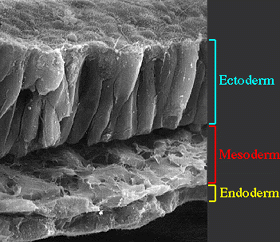 from Embryo Images Online
from LIFE: The Science of Biology, Purves et al, 1998 Show below are images of human embryos during gastrulation,13 - 19 days post ovulation. Notice the primitive streak, which is analogous to the blastopore of Xenopus.
Neurulation in vertebrates results in the formation of the neural tube, which gives rise to both the spinal cord and the brain. Neural crest cells are also created during neurulation. Neural crest cells migrate away from the neural tube and give rise to a variety of cell types, including pigment cells and neurons. Neurulation begins with the formation of a neural plate, a thickening of the ectoderm caused when cuboidal epithelial cells become columnar. Changes in cell shape and cell adhesion cause the edges of the plate fold and rise, meeting in the midline to form a tube. The cells at the tips of the neural folds come to lie between the neural tube and the overlying epidermis. These cells become the neural crest cells. Both epidermis and neural plate are capable of giving rise to neural crest cells. What regulates the proper location and formation of the neural tube? The notochord is necessary in order to induce neural plate formation.
Below are scanning electron micrographs of a chick embryo during neurulation.
During neurulation, somites form in pairs flanking the neural tube. Somites are blocks of cells that form a segmental pattern in the vertebrate embryo. Somites produce cells that become vertebrae, ribs, muscles, and skin. The region where neural tube closure begins varies between different classes of vertebrates. In amphibians such as Xenopus, the neural tube closes almost simultaneously along its entire length. In birds, the neural tube closes in the anterior to posterior direction, as Hensen's node regresses. Mammalian neurulation is similar to that of birds, however the bulky anterior neural plate seems to resist closure - the middle of the tube closes first, followed by both ends. Watch this animation of mammalian neurulation!
Animal development: Organogenesis Organogeneis is the period of animal development during which the embryo is becoming a fully functional organism capable of independent survivial. Organogenesis is the process by which specific organs and structures are formed, and involves both cell movements and cell differentiation. Organogenesis requires interactions between different tissues. These are often reciprocal interactions between epithelial sheets and mesenchymal cells. 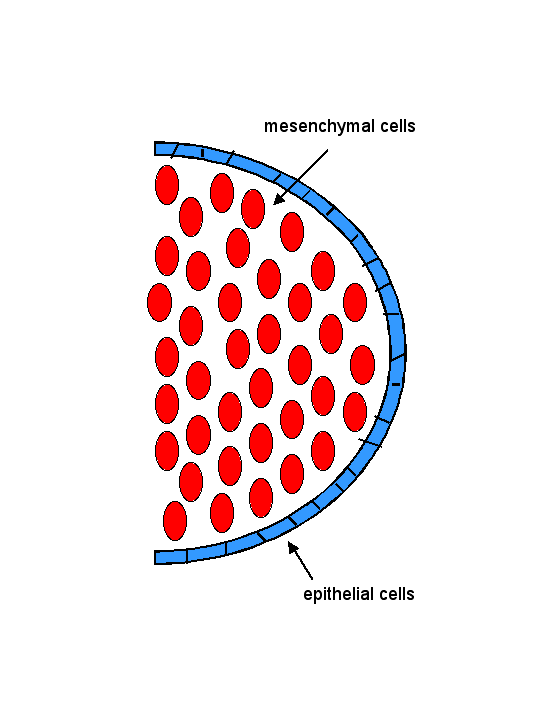 The study of organogenesis is important not only because of its relevance to understanding fundamental mechanisms of animal development, but also because it may lead to medical applications, such as the repair and replacement of tissues affected by genetic disorders, disease or injury. Kidney development There are three stages of mammalian kidney development: the formation of the pronephros, mesonephros, and metanephros (nephros = kidney; pro = before, meso = middle, meta = after). The metanephros is the permanent kidney found mammals (and in birds and reptiles), and forms at the region between the mesonephros and the cloaca (below).
The development
of the adult
kidney (metanephros) provides a good example of reciprocal
epithelial-mesenchyme
interactions. Mature (metanephric) kidneys form from reciprocal
inductions
between the metanephric mesenchyme and the (epithelial) ureteric buds.
Metanephric
kidney development
is a multistep process.
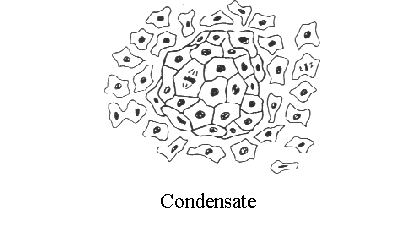  images from the Kidney Development Database 3. Each aggregate forms a nephron: first a comma shape is observed, and then the S-shaped tubule, which connects to the branched ureteric bud
What is the
experimental
evidence for reciprocal induction?
Vertebrate limb development Vertebrate limbs
develop
from limb buds. The vertebrate limb bud consists of a core of loose
mesenchymal mesoderm covered by an epithelial
ectodermal layer. Cells within the progress
zone rapidly divide, and differentiation only occurs once
cells
have left the progress zone.
Because
of this process, differentiation proceeds distally as the limb extends
(that is, the proximal end of the limb develops before the distal end).
The apical ectodermal ridge at tip
of limb bud induces the formation of the progress
zone.
Pattern formation organizes cell types into their proper locations based on positional information. Anterior-posterior patterning is regulated by the zone of polarizing activity, or ZPA. The current model is that proximal-distal pattern formation is regulated by the amount of time a cell spends in the progress zone. Dorsal-ventral patterning is controlled by the overlying ectoderm. What makes forelimbs
and hindlimbs different from one another? Pattern formation is
regulated
by the same signals in both limbs, although these signals are interpreted
differently. Limb-specific transcription factors have been
identified,
and by expressing these transcription factors in the OTHER (wrong)
limb,
scientists have been able to observe transformation of the hindlimb
into
the forelimb, and vice-versa.
from the Max Planck Society
Thanks to David Marcey for construction of some of the images shown above |